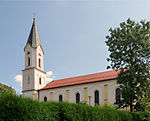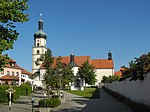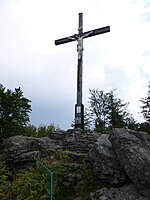Hoher Bogen

The Hohe Bogen (archaically often Hohenbogen) is a roughly 8-kilometre-long mountain ridge in the Bavarian Forest. It rises in the Bavarian province of Upper Palatinate in the county of Cham and is almost equally divided between the municipalities of Neukirchen b. Hl. Blut, Rimbach and Eschlkam between Furth im Wald and Bad Kötzting. Its territory includes, from northwest to southeast, the summits of the Burgstall (976 m), Bärenriegel (1,017 m), Eckstein (1,073 m), Schwarzriegel (1,079 m) and Ahornriegel (1,050 m). On the Burgstall there is a transmission site, on the Schwarzriegel is an old Luftwaffe transmission tower. On the northern slopes of the Ahornriegel is a ski area. A double chairlift, 1.36 kilometres long, transports passengers through 393 vertical metres in 15 minutes and runs to the top of the mountain.
Excerpt from the Wikipedia article Hoher Bogen (License: CC BY-SA 3.0, Authors, Images).Hoher Bogen
Am Schwarzriegel,
Geographical coordinates (GPS) Address Nearby Places Show on map
Geographical coordinates (GPS)
| Latitude | Longitude |
|---|---|
| N 49.233859 ° | E 12.934491 ° |
Address
sektor.f
Am Schwarzriegel 1-6
93485
Bavaria, Germany
Open on Google Maps










